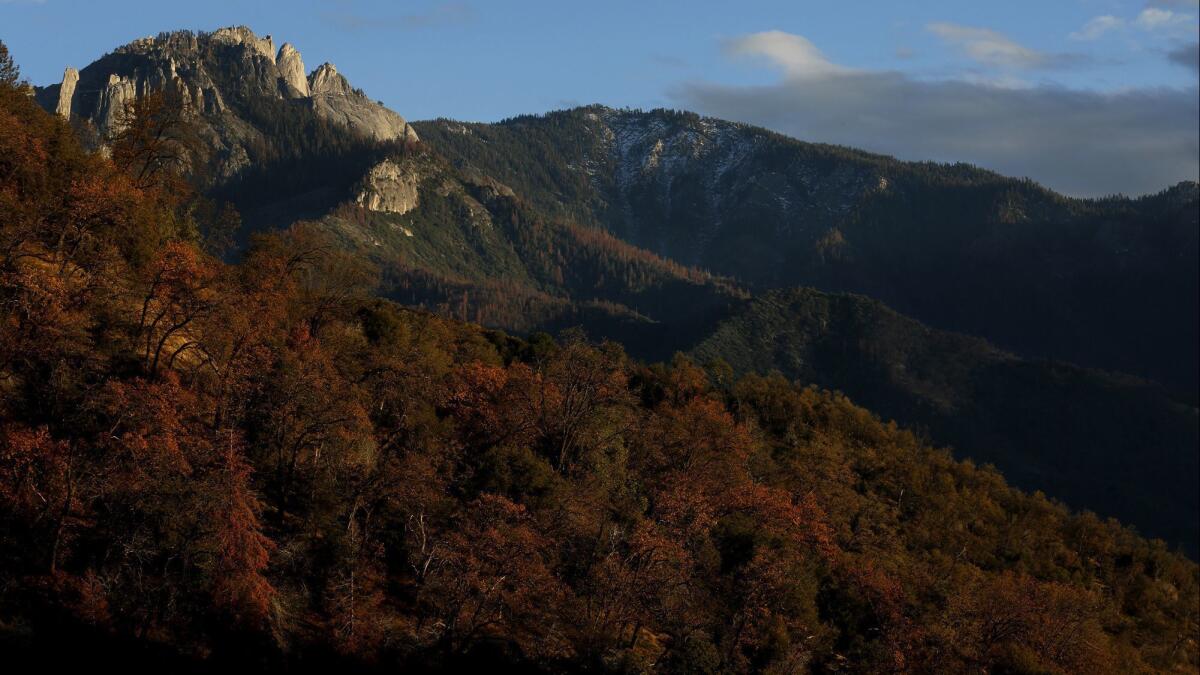18 million trees died in California last year; officials say that’s an improvement

- Share via
Another 18 million trees in California died over the last year, a grim toll that nonetheless officials see as a sign the epic forest die-off in the state’s mountains is finally slowing.
A study by state and federal forest officials released Monday noted that the 18 million dead trees since the fall of 2017 marks a major decline from the last study in 2016, which detected 62 million dead trees, and 2017, which found 27 million dead trees.
Officials credited the shift to more rain, which has lessened drought conditions in California forests and strengthened trees’ ability to fight off beetles.
In the last few years, California has seen the most devastating wildfires in its history as a result of the drought and beetle epidemic that, combined, kill off trees and generate more fuel for fires.
The beetles had been rapidly killing trees in the 4,500- to 6,000-foot elevation band of the central and southern Sierra range. It could take centuries for the trees to repopulate, if they ever do.
Beetle-ravaged trees on either side of the Merced River contributed to the damage done by the Ferguson fire last year, and the dead trees have made for hotter, more intense fires that have resulted in the devastation of the Thomas, Mendocino Complex and Camp fires.
Fire “moves very fast through dead needles, and dead trees produce a lot of dead needles,” said Mike Beasley, a fire behavior analyst for the U.S. Forest Service. “The dead pine needles, no matter where they end up, whether they’re still in the tree or draped in some old, decadent brush, or laying on the ground, they contribute significantly to rapid rates of spread.”
In all, more than 147 million trees have died across 9.7 million acres of federal, state, local and private land in the state since the drought began in 2010, according the study.
The slower tree mortality rate is encouraging, but it’s no cause to breathe a sigh of relief yet, experts say.
“Eighteen million trees is still a lot of trees,” said Randy Moore, regional forester for the USDA Forest Service.
To make a difference in the forests’ density, 500,000 acres of national forest land would have to be treated annually. To come up with that number, experts calculate how much forest management it would take to make the forest resilient enough to do minimal damage every time forest fires recur, approximately every 12 years, Moore said.
Since 2016, federal, state, and local agencies have felled 1.5 million dead trees in areas that pose the greatest risk to life and property, according to the U.S. Forest Service, the state’s Forest Management Task Force and the California Department of Forestry and Fire Protection. The devastation of recent fires has put the pressure on, urging agencies to work together on forest management.
As a result, this past year officials got closer to the 500,000-acre annual goal than ever before, treating about 300,000 acres of national forest land, Moore said.
“The community has come together,” Moore said. “It doesn’t matter whether it’s federal, private or state. It’s been working really well in a way I’ve not seen it in the past.”
Thom Porter, director of the Department of Forestry and Fire Protection, said it helps that the beetle population has been dying off, too.
“This has been an absolute epidemic in the southern Sierras to the point where there are no trees left,” he said. “They ran out of trees to eat.”
In other areas, tree health is improving enough that they’re able to ward off the beetles, he said.
But Porter said people should make no mistake — the next wildfire season will likely be just as devastating as the last despite the improvement in forest health. There may be fewer dead trees, but they’re adding to the existing dead trees that will be around for decades or until they’re burned up or removed.
The lower tree mortality “does not change that at all,” he said.“Regardless of rain or shine, we’re going to have large and damaging fires in California,” he said. “If it rains, we get grass. If it doesn’t rain, we have drought.”
So far, forest management has been focused on areas near people — along roads, trails and campgrounds, Moore said. Deep forest land has remained largely untouched.
Gov. Gavin Newsom has called for $1 billion toward a forest management plan over the next five years. That’s welcome news, and it would ensure the state has enough money to clear out forests, rather than spend on the purely reactive approach of fighting fires, Porter said.
“So, we are wanting to continue to invest in fuel reduction work that will protect the citizens of California, the forest ecosystem and watersheds of California,” he said. “But it’s going to take many many years for us to get to where we need to be relating to forest health.”
Twitter: @r_valejandra
More to Read
Sign up for Essential California
The most important California stories and recommendations in your inbox every morning.
You may occasionally receive promotional content from the Los Angeles Times.











